• BUILDING A MOVEMENT
• SUPPORT IN THE CONGRESS AND ADMINISTRATION
• EMPOWERING THE EXILE TIBETAN COMMUNITY
• CELEBRATING TIBET’S CHAMPIONS
• CHINESE OUTREACH
• ICT ON THE INTERNATIONAL STAGE
• ICT LEADERSHIP
• CONCLUSION
December 31, 2014
It is with humility and gratitude that I present these parting thoughts to the staff, members, supporters and friends of the International Campaign for Tibet (ICT). You have been the backbone of this organization and ICT would not have succeeded without you being a part of this effort. For almost 25 years I worked concurrently at ICT and as Special Envoy for His Holiness the Dalai Lama, and I relied heavily on your support and assistance in discharge of my duties.
Since its founding in 1988 the ICT team has devoted itself to supporting the Tibetan people and the vision of His Holiness the Dalai Lama. I am honored to have played a leadership role in this endeavor, from the inception of the organization to the present day. Now as I step down as Executive Chair of ICT and from its Board of Directors, I cannot help but reflect on my work here with a deep sense of satisfaction in our accomplishments.
When ICT first opened, the United States had no positive coherent policy toward Tibet or His Holiness the Dalai Lama, and it provided no humanitarian or development assistance to the Tibetan people. Today, not only is His Holiness welcomed to the White House with respect when he visits Washington, DC, but the U.S. Congress has awarded him their highest civilian honor — the Congressional Gold Medal. And it has passed historic, comprehensive Tibet legislation, the Tibetan Policy Act, as well as allocated an estimated $225 million for Tibet related programs and projects.
Our work in Washington has impacted the course of history for the Tibetan people by providing unprecedented support for their situation and by bringing their plight to the forefront of the world’s stage. The suffering and perseverance embodied in the Tibetan people’s recent history has moved some of the most powerful people in the world, enriching their understanding of the strength of the human spirit. Bringing these experiences to the attention of influential policy makers and being a part of developing a coherent, international response has brought me great professional satisfaction and personal joy.
During a recent visit to London, the President of the Tibetan Community in Britain, Tsering Passang, asked me to share the recipe for my success in advocating for the Tibet cause at an international level. As I said then, it is three-fold. First, I have a passionate belief in the cause of the Tibetan people and an unwavering commitment to serve under the leadership of His Holiness the Dalai Lama. Second, I have sought out colleagues and associates who are wiser and more capable than myself—individuals who are willing to think creatively and not simply agree with everything I say. The team we assembled has brought unparalleled intelligence, talent and commitment to our efforts, and through vigorous intellectual discourse they have contributed unique insights and perspectives to our cause. Finally, I have never been afraid to seek help, and I have been able to establish relationships of trust with people who have the power to assist us in our efforts. I have been fortunate to receive guidance from some of the world’s greatest leaders, officials and scholars of our time, whether it is in India, the United States or elsewhere.
Thus, our success in Washington is not mine alone to celebrate; it is the success of a devoted and committed team. And it is this success that I want to reflect on in this brief report.
After lengthy deliberations, His Holiness the Dalai Lama and the Tibetan leadership made the decision to reach out to the Chinese leadership by other means – by creating international awareness of Tibet and by seeking the support of global leaders for our effort to begin substantive dialogue. The Chinese leadership was becoming more sensitive to international opinion and was aggressively courting Western nations to help realize their ambitious plan to modernize the Chinese economy. This gave the international community an unprecedented opportunity to help move forward the issue of Tibet.
At that time, I was a member of the Kashag, the Tibetan Cabinet, appointed by His Holiness the Dalai Lama. My colleague Kalon (Minister) Tashi Wangdi and I spearheaded our international efforts along with the Department of Information and International Relations (DIIR) Secretary Sonam Topgyal and other senior officials, as well as His Holiness’s representatives at the Offices of Tibet abroad.
Because we had such limited resources, the Tibetan leadership decided to focus our global efforts on Western developed nations, starting with the United States, and then moving on to countries in Europe.
When His Holiness the Dalai Lama visited Washington, DC in 1987 to announce his historic Five Point Peace Plan on Capitol Hill, it was part of this well thought-out strategy. Encouraged by the tremendous response to this visionary speech, we knew that it was time to create a permanent Tibetan presence in Washington, DC.
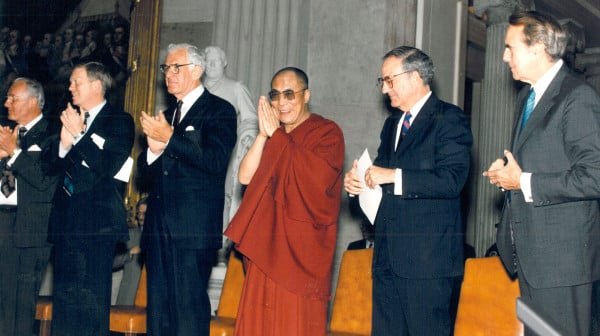
Following the presentation of 5 Point Peace plan in the Capitol Rotunda with The Honorable Richard Gephardt; Speaker Thomas Foley; His Holiness the Dalai Lama, Senator George Mitchell, Senator Robert Dole.
(Photo: U.S. House of Representatives)
For some time we had known how important it was to establish a presence in Washington, DC. Several years earlier we had secured representation by the prestigious law firm, Wilmer, Cutler & Pickering, with the assistance of longtime Tibet supporter, Dr. Michael van Walt. Michael van Walt had been closely associated with His Holiness the Dalai Lama and the Tibetan leadership since the early 1970s and he was the main organizer of His Holiness the Dalai Lama’s first visit to the West in 1973 when he travelled to several European countries. Michael’s professional and personal assistance was, and has continued to be, of immense value to our international efforts, and in the 1980s he helped arrange for Wilmer, Cutler & Pickering to register as a Foreign Agent providing pro-bono representation to His Holiness and the Central Tibetan Administration.
Another person who has been of much help with our initial international efforts is Joel McCleary, a political strategist who was a senior staffer at the White House during the Carter Administration. Joel has a unique ability to see the big picture and think outside the box while strategizing. I have always greatly appreciated his creative input.
After His Holiness gave his speech in Washington enunciating his Five Point Peace Plan, we knew the time was right to create a more visible presence in Washington, DC. Tenzin Tethong, myself and Rinchen Dharlo the newly-appointed Representative of His Holiness in the Office of Tibet in New York held discussions with such friends as Michael van Walt, Joel McCleary, John Avedon, Bob Thurman, and Jeffrey Hopkins and we concluded that it was critical that we form an American non-governmental organization (NGO) that would be in compliance with U.S. laws and operate independently, as other NGOs do in Washington. Thus, the International Campaign for Tibet was born.
Tenzin Tethong played a key role in formulating the vision of ICT and the very name “international” hinted at its subsequent expansion beyond Washington, D.C. and the United States. At the time, Tenzin Tethong was finishing up his tenure as His Holiness’s representative in New York and seeing the importance of such a presence in Washington, His Holiness asked him to stay back as his Special Representative to lead the effort. I was instructed to convey this to my colleagues in the Tibetan Kashag for formal approval. Tenzin Tethong’s diplomatic experience and skills in team building, coupled with his personal style and sophistication, made him the best choice to lead this effort.
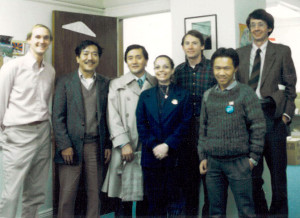
The ICT staff the early years with John Ackerly, Tenzin Chogyal, Tenzin N. Tethong, Michele Bohana, Mac McCoy, Warren Smith and a Tibetan volunteer. (Photo: ICT)
Who would have thought that in such a short period of time Tenzin Tethong and I would switch roles? In 1990 His Holiness decided to move forward with major democratic reforms, dissolving the Kashag and convening a special congress of exiled leaders (May 11th -17th, 1990) to elect an interim Kashag for one year. His Holiness personally addressed this important gathering and advised that the Tibetan Parliament work on a charter to establish a future administrative structure, as well as mechanisms for the election of the members of the Kashag and the Parliament. Until then all Kalons were directly appointed by His Holiness. Tenzin Tethong came to the special congress as a delegate and was one of only three that was elected to the Kashag, obtaining more than 70% of the votes required. He thus became a member of the Tibetan Kashag and I came to Washington, DC as the Special Envoy of His Holiness the Dalai Lama and was soon elected by the Board of ICT to be its President.
When ICT opened, Tibet was still considered a relatively obscure “issue” to decision makers in Washington, DC. A few lawmakers were aware of China’s human rights abuses in Tibet and were deeply concerned about China’s repressive brand of communism, including Congressmen Charlie Rose, Benjamin Gilman, Tom Lantos, John Porter, Nancy Pelosi, Chris Smith, and Frank Wolf, and Senators Claiborne Pell, Jesse Helms, Edward Kennedy, Daniel Patrick Moynihan, and Patrick Leahy. But for the most part Tibet was a small sidebar to the larger issue of U.S. relations with China.
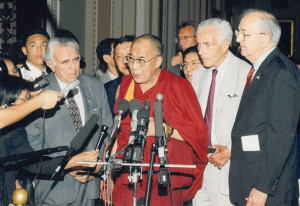
His Holiness addresses the media following a meeting on Capitol Hill with The Honorable Benjamin Gilman, Senator Claiborne Pell and Senator Jesse Helms. (Photo: Nancy Jo Johnson)
But supporters of Tibet, not to mention people who had even heard of Tibet outside of references to Mt. Everest or Shangri-la, were few and far between. Volunteers from those early days have noted that when they saw a Tibet bumper sticker, it was 100 percent guaranteed that they would personally know the driver of the car, often joking that my family accounted for 50% of the Tibetans in the Washington area.
In ICT’s first years, Tenzin Tethong and I tirelessly met with House and Senate staff, with an occasional face-to-face meeting with a member of Congress. We met with anybody in the Administration who would meet with us, although we weren’t allowed in the State Department or White House buildings and had to meet in coffee shops and hotel tea rooms around the city. One notable exception occurred during the Reagan Administration. Mr. Elliot Abrams, who was then the Assistant Secretary for Human Rights, invited Tenzin Tethong and I to the State Department for a formal meeting. His counterparts from other Bureaus strongly objected, so this advancement was short-lived. Still, the issue of Tibet slowly gained a foothold, due to years of patiently knocking on doors and making cold calls to congressional offices and administration officials.
While the senior staff of ICT pounded the pavement, once a month a handful of volunteers would sit on the floor of the ICT office and compile photocopies of press clippings on Tibet. Stapling, stuffing envelopes and laughing, these committed people, including such dedicated friends as then-Congressional staffers Keith Pitts and Paul Berkowitz, helped build a membership base that started with less than one hundred, and has grown to almost 100,000 individuals today.
And, from a team of four in the cramped K Street office, ICT has grown to a staff of almost thirty, with its own brownstone in downtown Washington, DC (purchased with seed money generously provided in his will by my good friend, the late Thomas Lundstrom), as well as offices in Brussels, Amsterdam and Berlin. ICT’s credibility and effectiveness has been compared to the Israeli lobby. With a relatively small staff and a constrained budget, ICT has posed a formidable challenge to the might of the People’s Republic of China, forcing China to enlist the help of American industries to counter our successful advocacy. This has earned ICT the respect and admiration of many people for so effectively challenging this massive force.
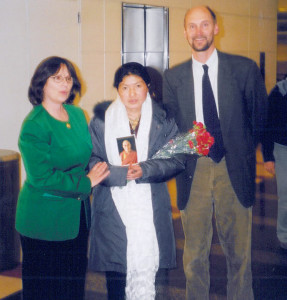
Mary Beth Markey and John Ackerly receiving just released former political prisoner Ngawang Sangdrol (Photo: ICT)
John Ackerly, who succeeded me as President of ICT, built it to become the most effective and largest international Tibet NGO in the world. It was he who integrated a very strong grassroots advocacy into the mission of ICT and it was he who understood the strength of a membership-based organization. John’s vision became the model for other ICT offices in Europe and is the reason for much of their successes thus far. Mary Beth Markey joined ICT in 1996 as Director of Government Relations and succeeded John Ackerly as President in 2010. Mary Beth came to us with many years of experience working for the late Senator Claiborne Pell at the Senate Foreign Relations Committee, where she worked on significant early Tibet legislation. Mary Beth was a skilled advocate who was instrumental in developing a comprehensive global advocacy strategy for ICT during her presidency.
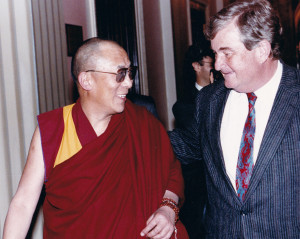
His Holiness the Dalai Lama with The Honorable Charlie Rose. (Photo: ICT)
While ICT maintained its independence as an American NGO, we have worked very closely with the Tibetan leadership on all major matters. ICT enjoyed the full confidence of the secretariat of His Holiness the Dalai Lama and successive cabinets in Dharamsala headed by Katri Kalsang Yeshi, Katri Gyalo Dhondup, Katri Tenzin Tethong and the late Katri Sonam Topgyal. In particular I would like to mention the close working relationship that we enjoyed during Professor Samdhong Rinpoche’s ten years as Kalon Tripa (Chairman of the Kashag). Similarly, here in the United States, ICT and the Office of Tibet worked with very close cooperation at every level. The individuals were immaterial; what was important was to deliver tangible benefits for the people of Tibet. Rinchen Dharlo was His Holiness’s representative when ICT first opened, and remained in the post for many years. During his time we were able to lay a very firm foundation for the work to come. ICT’s relations continued in that manner with Kasur Dawa Tsering, Dr. Ngawang Rabgyal, Kasur Tashi Wangdi and then Kasur Lobsang Nyandak.
Working as a team we focused on moving forward the agenda of His Holiness the Dalai Lama and the people of Tibet. The Kashag acknowledged the working relationship between ICT and the office of Tibet as exemplary because the issues were given precedence over institutions or personalities. During one of his visits to the United States, the then-Kalon Tripa Sonam Topgyal, personally expressed the Kashag’s appreciation and complimented me and Rinchen Dharlo for our teamwork. But the most heartwarming for Rinchen Dharlo and me was that His Holiness the Dalai Lama himself was pleased with our work. With the Office of Tibet for the Americas under Kaydor Aukatsang now based in Washington, D.C. it should make cooperation and coordination even easier.
When I reflect back on these first years of ICT, I feel immense gratitude for our early supporters. The handful of Members of Congress who were willing to champion this “obscure” issue, the dedicated staff and volunteers who had been touched by the issue of Tibet either through dharma, travels or study—these hard working and passionate individuals helped launch an international voice for His Holiness the Dalai Lama and the people of Tibet. The successes of our movement thus rest, in no small part, on their shoulders.
The mission and work of ICT has been guided by the vision of His Holiness the Dalai Lama. His Holiness’s commitment to a peaceful, negotiated solution in Tibet has served as our beacon and we have strived to support his efforts to bring peace and stability to Tibet. ICT adopted a firm policy of supporting self-determination for the Tibetan people, based on the understanding that it is for the Tibetan people to decide their own future and that it is the role of friends and supporters to support them, not to tell the Tibetans what their future should be.
As the Special Envoy of His Holiness the Dalai Lama, I relied heavily on ICT, especially in organizing His Holiness’s Washington, DC visits. ICT assisted me in setting up his meetings with the President, Vice President, Secretary of State, National Security Advisor, and leadership of the U.S. House and Senate—from Presidents George H.W. Bush, Bill Clinton, George W. Bush and Barack Obama; to Speakers Thomas Foley, Newt Gingrich, Nancy Pelosi, and John Boehner ; from Secretaries of State Warren Christopher, Madeleine Albright, Condoleezza Rice, Colin Powell, and Hillary Clinton, to former President Carter, U.S. Ambassador to the U.N. Richard Holbrooke and Deputy Secretary Richard Armitage and others.
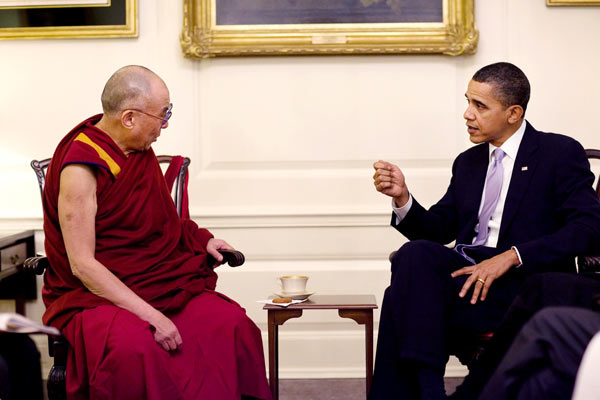
His Holiness the Dalai Lama meeting with President Barack Obama, 2011. (Photo: The White House)
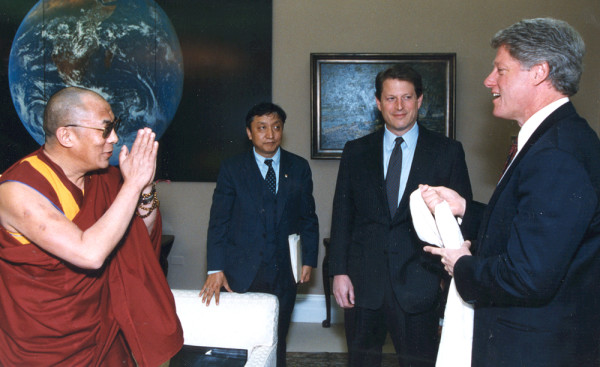
His Holiness the Dalai Lama greets President Clinton and Vice President Gore, with Lodi Gyari in the
Vice President’s office in 1995. (Photo: The White House)
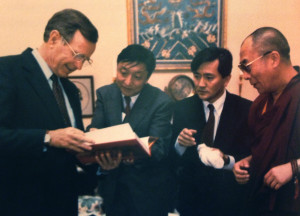
President George H.W. Bush with Lodi Gyari, Tenzing N. Tethong and His Holiness the Dalai Lama in 1991.
(Photo: The White House)
I want to focus briefly on the significance of the meeting between His Holiness the Dalai Lama and President George H.W. Bush in 1991. This was the first meeting between His Holiness and an American president and it set the precedence for subsequent meetings between His Holiness and other world leaders. Arranging this meeting took a tremendous amount of hard work and effort, and I was fortunate to receive guidance and support from many friends both inside and outside the government, including members of Congress. The President’s cousin Elsie Walker, a devoted friend of Tibet, also played a critical role. Tenzin Tethong, who was in the Tibetan Kashag and responsible for International Relations, was able to participate in that historic meeting in the White House.
ICT has also been instrumental in arranging widely attended public talks by His Holiness the Dalai Lama in Washington, DC, from the U.S. Capitol, to Constitutional Hall, to the Verizon Center. He has met with members of the U.S. Supreme Court, the leadership of powerful think tanks in Washington, and groups of eminent Chinese scholars from both inside and outside the People’s Republic of China.
Each of His Holiness’s visits to Washington and his meetings with dignitaries has helped to raise the profile of the Tibet issue around the world and to put pressure on the Chinese government to treat His Holiness the Dalai Lama and his efforts at negotiation with seriousness and respect. Furthermore, these high profile meetings and forums organized by ICT have provided the foundation for the tremendous support for Tibet and His Holiness in Congress.
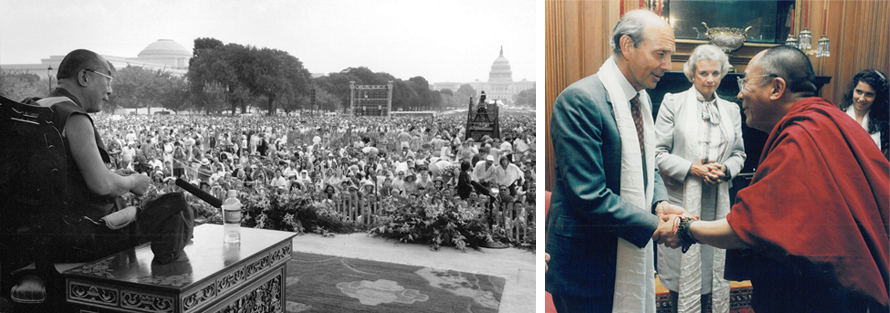
[ LEFT ] His Holiness the Dalai Lama at the Smithsonian’s Folklife Fesitval in July, 2000. (Photo: ICT/Sonam Zoksang)
[ RIGHT ] His Holiness the Dalai Lama meets Justice Bryer and Justice O’Conner as Rev. Chloe Bryer looks on. (Photo: The U.S. Supreme Court)
TIBET IN THE CONGRESS
In 1987 the Congress welcomed His Holiness the Dalai Lama to Washington, DC via resolutions introduced by Senator Claiborne Pell and Congressman Charlie Rose. Following the visit that year hosted by the Congressional Human Rights Caucus under Congressmen Tom Lantos and John Porter and the opening of ICT in 1988, legislative activity on Tibet escalated rapidly. Since then dozens of resolutions have passed expressing support for His Holiness the Dalai Lama, condemning China’s human rights and environmental policies in Tibet, and providing direct assistance to the Tibetan people, both inside and outside Tibet.
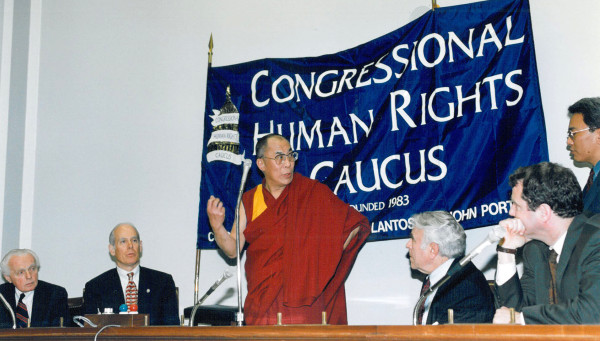
His Holiness addresses the Congressional Human Rights Caucus with The Honorable John Porter and The Honorable Benjamin Gilman. (Photo: ICT)
In those early years legislation on Tibet centered either on resolutions condemning China’s human rights policies in Tibet, or providing assistance of one sort of another to the Tibetan people. But in 1989, we were able to link the issue of Tibet to the massive debate over the continued Most Favored Nation (MFN) trading status of China. This debate topped U.S. headlines in the aftermath of the 1989 Chinese crackdown in Tiananmen Square, as it became the chief vehicle for the U.S. to “sanction” China’s abysmal human rights transgressions. Ultimately President Bill Clinton chose to give China the preferential trade status, but he made it conditional on several human rights issues, including an improvement in Tibet. Even though progress was ultimately not made on human rights or on Tibet, and China later did get an extension of MFN, being a part of the debate launched the issue of Tibet to a new level of acceptance in official Washington. When the President signed the bill conditioning MFN’s renewal, I was invited to the White House to be a part of the ceremony, marking the first time that a Tibetan representative was invited to an official bill signing ceremony.
Another historic legislative event occurred in 1991 when the U.S. Congress passed a resolution recognizing all Tibetan areas as an occupied country, identifying Tibet as the Tibet Autonomous Region (TAR) as well as all Tibetan Autonomous Prefectures and Areas. “It is the sense of the Congress that Tibet, including those areas incorporated into the Chinese provinces of Sichuan, Yunnan, Gansu and Qinghai, is an occupied country under the established principles of international law whose true representatives are the Dalai Lama and the Tibetan Government in exile as recognized by the Tibetan people [SConRes257].”
Although this legislation compelled no action, it was the first time that the United States, or any government, formally acknowledged that Tibet was more than just the TAR, and that it encompassed the entire area that His Holiness and the Tibetan people know to be Tibet. This created an enormous boost to the morale of Tibetans from every corner of Tibet who were yearning for a unified Tibet. Personally, this legislation was of immense importance to me, and while I have worked hard on all of our congressional efforts, I may have worked hardest on this one. This was the first, and remains today the only, official declaration recognizing all Tibet areas as one entity and it reflects the historic decision by the Tibetan people to reassert themselves as one nation.
Congressional support for Tibet reached new heights in 2001 when Senator Dianne Feinstein and Congressman Tom Lantos introduced the Tibetan Policy Act. The Act was developed through intense discussions between ICT, the Administration and the Congress, with the goal of articulating U.S. policy on Tibet, codifying support for the Tibetan people, and formalizing a senior position in the U.S. government with a Tibet portfolio. With our aggressive advocacy, by the end of that first year this legislation had accumulated over 100 co-sponsors. The Act passed one year later, and remains today the most ambitious, supportive and comprehensive piece of legislation that any country has passed on Tibet. It contains dozens of political and programmatic provisions ranging from humanitarian assistance to formalizing the office of the U.S. Special Coordinator for Tibetan Issues at the State Department. It codified U.S. Tibet policy just as the Taiwan Relations Act protects the special U.S.-Taiwan relationship.
Since the passage of the Tibetan Policy Act, ICT has sought to institutionalize the Tibet issue within the U.S. government’s foreign policy. Thus, for the first time in 2004 the annual Department of State’s country reports on human rights contained comprehensive reporting on all Tibetan areas, including Tibetan autonomous areas outside of the Tibet Autonomous Region.
There are a number of congressional staff over the years who have remained loyal friends of Tibet ever since and played a crucial role in helping our efforts in the Congress, including Gare Smith, Keith Pitts, Paul Berkowitz, Bill Triplett, Alexandra Arriaga, Carolyn Bartholomew, Jonathan Stivers, Tim Reisser, Mary Beth Markey, Mark Laigon, Ellen Bork, Michael Schiffer, Rob Gustafson, Peter Gailbraith, Kay and Bob King, Rachel Lostumbo, Jeannette Windon, Kelley Currie, Charlotte Oldham-Moore, Todd Stein and others too numerous to mention. Many of them have remained significantly engaged on Tibet, even after moving on to different positions. Keith Pitts, Gare Smith and Ellen Bork currently serve on the ICT Board. Rachel Lostumbo, Mary Beth Markey, Kelley Currie, Charlotte Oldham-Moore and Todd Stein became colleagues at the ICT where they headed the government relations efforts.
There are two Members of Congress that I would like to especially mention because of their support and commitment specifically to the Tibetans inside Tibet—Senator Patrick Leahy and Congresswoman Nancy Pelosi. Both of these lawmakers have taken a special interest in securing funding to help those Tibetans who are suffering the most. In fact, for many years Nancy Pelosi would not support projects that provided funding to China. It was only because of her desire to help the Tibetan people that she allowed a waiver for funding Tibet-related projects in China. It is ironic that some of the NGO’s that are the recipients of this special Tibet funding still want to avoid an association with Congresswoman Pelosi because of a fear of displeasing the Chinese. I would also like to thank Congresswoman Pelosi for the official visit she made to Dharamsala in 2008, during her term as Speaker of the House. The purpose of her trip was to lend her support to His Holiness the Dalai Lama and the Tibetans at a time when massive demonstrations throughout Tibet were being ruthlessly suppressed by the Chinese authorities. I deeply appreciate this support for the Tibetans inside Tibet—infusing hope and encouragement to the Tibetan people inside Tibet is more important than anything else. The future or the fate of the Tibetan people will be decided by not those of us in exile but by the Tibetans inside.
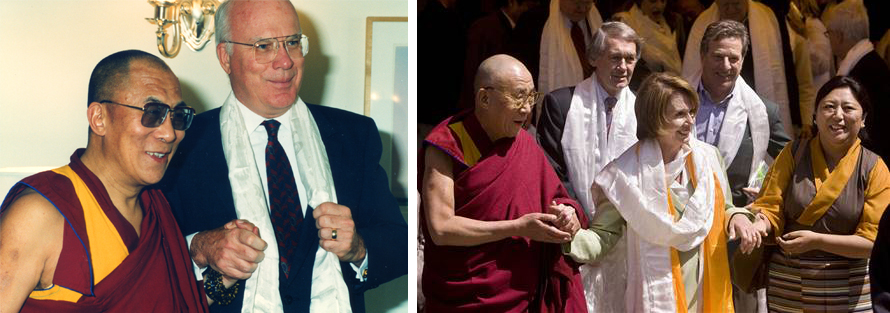
[ LEFT ] His Holiness and Senator Patrick Leahy.
[ RIGHT ] Speaker Nancy Pelosi in Dharamsala with His Holiness the Dalai Lama and Kalon Dolma Gyari.
SPECIAL COORDINATOR FOR TIBETAN ISSUES
As support for Tibet grew in the United States, we began to push for the appointment of a senior U.S. official with a Tibet portfolio. In 1993, bipartisan bills were first introduced in the House and Senate to create a “United States Special Envoy for Tibet.” Under this initial formulation, the Special Envoy would be appointed by the President, have the rank of ambassador, and be located in the State Department.
The next four years saw negotiations between Congress and the Clinton Administration over this position, with ICT deeply involved every step of the way. The result of these negotiations was the appointment in November 1997 of the first Special Coordinator for Tibetan Issues within the State Department, created under the authority of the Secretary of State. ICT helped develop a compromise between Secretary of State Madeleine Albright and Senators Dianne Feinstein and Jesse Helms to ensure that this position was not relegated to either the Asia-Pacific Bureau or the Human Rights Bureau in the Department of State, which would have limited its reach. As noted above, this position was codified by Congress in the Tibetan Policy Act of 2002.
Each Special Coordinator has brought his or her own perspective to the position and helped advance the issue in a unique way. Secretary Madeline Albright appointed Gregory Craig as the first Special Coordinator for Tibet. At the time Gregory Craig was the Director of Policy Planning at the State Department and under his leadership the Office of the Special Coordinator opened its doors. When he left the State Department to join President Clinton’s White House, Julia Taft, the Assistant Secretary for Population, Migration and Refugees, became the Special Coordinator. With her background and passion in refugee issues, Julia Taft put her heart into the post. Upon leaving the State Department she was so personally dedicated to the issue that she joined ICT’s Board of Directors. Her passing was a tremendous loss for the Tibetan people and refugees everywhere.
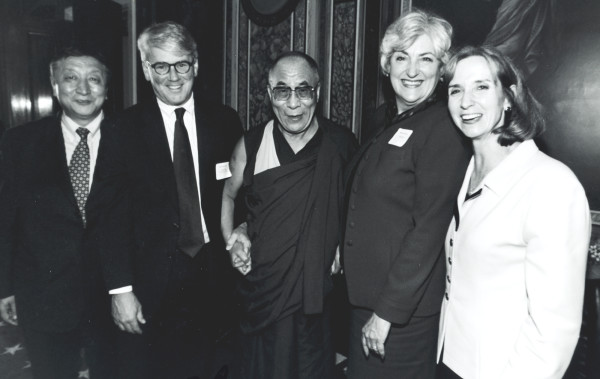
Lodi Gyari, The Honorable Greg Craig, His Holiness the Dalai Lama, The Honorable Julia Taft and Ambassador Paula Dobriansky on May, 21, 2001. (Photo: ICT Sonam Zoksang)
For the entirety of the Bush Administration, Ambassador Paula Dobriansky held the title and she raised the political voice of the office – actively engaging her European counterparts by hosting strategy meetings with like-minded Ambassadors. She was a firm advocate for implementing a strong U.S. influence on the dialogue process. Ambassador Dobriansky and I worked hard to develop public/private partnerships to create a strong funding source for Tibet-related projects, bringing First Lady Laura Bush into the effort. Unfortunately, due to a number of reasons, we were unable to bring this project to fruition.
Under President Obama there have been two Special Coordinators. The first, Under Secretary Maria Otero, was named after some delay but was a strong advocate for Tibet. Her first act upon receiving the Tibet portfolio (even before it was formally announced) was to travel to Dharamsala with presidential advisor Valerie Jarrett. Soon after there were historic changes in Dharamsala, including my own transition, so we have not been able to take as much advantage of the office as we have in the past. Now Under Secretary Sarah Sewell holds the post and I’m very pleased that she recently visited Nepal and India to draw further attention to Tibet.
Of course, all the Special Coordinators have been assisted by very capable and dedicated staff who have been committed to helping the Tibetan people, most of them I’ve already mentioned herein but there are two, Jonathan Levitsky and Kate Friedrich who had a profound impact. Jonathan Levitsky was the first staff person and did much to establish it and Kate Friedrich who served the longest through two Administrations under both Julia Taft and Ambassador Dobriansky and made it the robust and effective office it is today.
The passage of the Tibetan Policy Act and the appointment of the Special Coordinator for Tibetan Issues were watershed moments for Tibet. For the first time in Tibet’s history, a U.S. government official was responsible for becoming an expert on Tibet and coordinating Tibet policy. And for the first time the Congress directed State Department policy on Tibet through the mission of the Special Coordinator.
CONGRESSIONAL GOLD MEDAL
In 1991 Congress assembled in the U.S. Capitol Rotunda to welcome His Holiness the Dalai Lama in an event coordinated by ICT. This historic event helped pave the way for another event held in the Capitol Rotunda in 2007, when the U.S. Congress awarded the Congressional Gold Medal to His Holiness, culminating years of advocacy by ICT.
Since America’s independence, Congress has commissioned gold medals as its highest expression of national appreciation for distinguished achievements. Congressional Gold Medal legislation must be cosponsored by at least two-thirds of the House of Representatives (290 members) and the Senate (67 members). The first recipient was George Washington in 1776. Other recipients include Dr. Martin Luther King, Robert Kennedy, and Elie Wiesel.
When Congress awarded the Congressional Gold Medal to the Dalai Lama in 2007, it represented hundreds of hours of ICT advocacy, whether it was coordinating grassroots campaigns in support of this legislation, or high-level discussions between myself and Members of Congress and the Administration. ICT had a huge countdown calendar posted on the wall, with daily goals and thousands of volunteers engaged on every level. Like with the Nobel Peace Prize, the success of this effort demonstrated the global respect His Holiness engenders. And the fact that so many people came together to help bestow this honor on His Holiness that he so justly deserves illustrates how wide and how deep his support has spread in the United States.
![His Holiness the Dalai Lama accepting the Congressional Gold Medal [The Rotunda, US Capitol, Washington, DC, October 17, 2007]](https://savetibet.org/wp-content/uploads/2013/03/33-CGM-600.jpg)
First Lady Laura Bush, His Holiness the Dalai Lama, Speaker Nancy Pelosi, Majority Leader Byrd and President George W. Bush at the presentation of the Congressional Gold Medal. (Photo: ICT/Sonam Zoksang)
When the Congressional Gold Medal ceremony was held in the U.S. Capitol Rotunda, it marked the first time that an American President publicly honored His Holiness the Dalai Lama for his leadership. At the ceremony President George W. Bush spoke of his support and admiration for the Dalai Lama. He was flanked by the congressional leadership, and thousands gathered in Washington for the ceremony and surrounding festivities.
SUPPORT FOR DIALOGUE
ICT has consistently focused on ground conditions for Tibetans inside Tibet and in exile, but the goal of our advocacy has been to support His Holiness the Dalai Lama’s Middle Way approach—a peaceful resolution for Tibet through dialogue between his representatives and Chinese government officials.
As His Holiness the Dalai Lama’s chief interlocutor in my position as his Special Envoy, I spent decades educating U.S. policy makers about efforts to reach out to the Chinese government through background memos and briefings. I felt strongly, and continue to believe, that it is only with strong international support that the Chinese government will interface with us to seek a mutually beneficial solution. Thus, American Presidents, Cabinet members and Members of Congress have continuously encouraged the Chinese government to engage in a dialogue with His Holiness the Dalai Lama’s representatives. President Bill Clinton and President George W. Bush gave the Tibet issue high priority and I worked very closely with their senior aides. Their involvement was of immense value and helped sustain our dialogue with the Chinese government.
The Chinese government has always been adamant about not accepting any third party involvement in our dialogue, and we also felt that direct third party participation would not be advantageous as it might constrain our position on some issues. However, we successfully integrated Tibet in multilateral and bilateral discussions between the Chinese government and various nations and international organizations, which helped put pressure on the Chinese to begin a dialogue on the Tibet issue.
![His Holiness the Dalai Lama with US Senators Hillary Clinton and Dianne Feinstein [The Willard Hotel, Washington, DC, May 2001]](https://savetibet.org/wp-content/uploads/2013/03/17-hhdl-hillary-clinton-difi-600-300x190.jpg)
Senators Hillary Clinton and Dianne Feinstein with His Holiness the Dalai Lama. (Photo: ICT/Sonam Zoksang)
We did not limit our outreach for help to Western leaders. I journeyed to several Asian countries and met with leaders like the Indonesian President, Abdurrahman Wahid, and former Prime Minister of Thailand, Mr. Anand Panyarachun. Both of these leaders were very kind to lend their support to our efforts. Many individual Chinese, including several from mainland China gave encouragement and help to our efforts. For obvious reasons I cannot mention their names at this stage.
Parliamentary resolutions encouraging continued dialogue also added visible global commitment to the issue of Tibet. The United States Congress passed a law making it mandatory for the President and the Secretary of State to submit a yearly report on the status of the dialogue. In 2003 the United States issued its first report on its efforts to promote dialogue between the Chinese and the Tibetans, The Status of Tibet Negotiations, mandated by the Tibetan Policy Act. As President Bush affirmed in this report, encouraging substantive dialogue is a “key objective” of the administration’s policy and a lack of resolution to the Tibetan problem would be a “stumbling block to fuller political and economic engagement between the United States and China.”
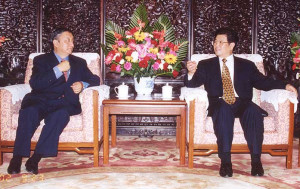
Lodi Gyari meeting with Wang Zhaoguo, head of the Central United Front Work Department of the Chinese Communist Party in September, 2002.
I was fortunate to have Envoy Kelsang Gyaltsen as my colleague for this difficult but important task, and we were assisted by a team of dedicated and professional Tibetans. We had no illusions that the deeply complex issue could be resolved by us shuttling back and forth, but we conducted these talks according to the highest diplomatic norms and standards with the hopes that these talks would lead to a negotiated settlement. The firm leadership and clear directive provided by Professor Samdhong Rinpoche, the then-Kalon Tripa of the Central Tibetan Administration, was of critical importance to this historic dialogue process. Substantive issues were discussed including the presentation of the Memorandum on Genuine Autonomy for the Tibetan People, which was conveyed to the Chinese government during the eighth round of dialogue in November of 2008.
My delegation made sincere and serious effort to convince the Chinese leaders of His Holiness the Dalai Lama’s firm commitment to seek a solution for the future of Tibet without independence and within the Peoples Republic of China (PRC). We were also explicit and firm on three fundamentally important positions as directed by His Holiness the Dalai Lama and the Tibetan leadership: 1) that whatever solution was worked out must address all the Tibetans and encompass all the areas inhabited by Tibetan people, 2) that while our commitment to seeking a solution within the PRC was genuine, we could not accept a falsified and distorted version of our history and, 3) that the issue confronting us was not about the title, the function or the future of His Holiness the Dalai Lama but that of the six million Tibetans and their place within the People’s Republic of China.
In this endeavor I took every opportunity to seek the opinion and guidance of fellow Tibetans from inside Tibet because they have a far better understanding of the situation on the ground as well as the mindset of the Chinese leaders. Their input has been of tremendous value to us in having a better understanding of the aspirations and hopes of the Tibetans living under Chinese rule. I certainly cannot jeopardize their well being by disclosing the names of those who are still living, but the late Baba Phuntsok Wangyal’s deeply thoughtful views have been of great value to me. I felt a deep sense of loss when he passed away.
In 2011, His Holiness the Dalai Lama took the historic decision to transition all political power and responsibilities to the Tibetan people, and Dr. Lobsang Sangay was directly elected by the Tibetans in exile and took office on August 8, 2011 to lead the new government. I also announced my decision to step down as His Holiness’s Special Envoy both reflecting the change in the government as well as my own independent decision. I felt strongly however, that the dialogue process must be sustained. Therefore, in clear consultation with both the outgoing head of the Kashag, Professor Samdhong Rinpoche and the leader-elect Dr. Lobsang Sangay, I stayed on in my position for a short period of time to maintain the dialogue process. Soon, however, it became clear that my continuing in this position was not productive so I submitted my final resignation on June 1, 2012.
I am a firm believer in the wisdom of His Holiness’s approach and sincerely hope that the two sides will make serious efforts to reengage in order to seek a solution that both can live with. Both the Tibetan leaders as well as the Chinese must realize that His Holiness the Dalai Lama is the solution to this complex issue and try to come to an understanding on the basis of his far-sighted vision.
SUPPORT FOR THE TIBETAN PEOPLE
While His Holiness provides the leadership for ICT’s mission, the inspiration for our advocacy at ICT comes directly from the Tibetan people. From its earliest days, we worked to bring the plight of the Tibetan people and the Tibetan plateau to the attention of the international community. Throughout the past 25 years ICT has used every tool at its disposal to highlight the situation in Tibet—sending fact-finding missions, organizing demonstrations and press briefings, issuing reports and documentaries, and pursuing aggressive political advocacy.
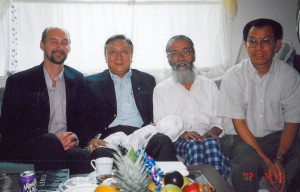
John Ackerly, Lodi Gyari and Bhuchung Tsering with newly released political prisoner Takna Jigme Sangpo. (Photo: ICT)
ICT has also focused on securing concrete assistance for the Tibetan people inside Tibet and for Tibetan refugees. One early program provided by the Congress was a one-time allocation of 1000 special immigration visas for Tibetans, which eventually led to several more thousand Tibetans coming to the United States through family reunification. Whether keeping Tibetan people informed about current events around the world (through Tibetan language radio programs) or providing much-needed educational support (through humanitarian assistance), these programs like this brought untold benefits to the Tibetan population both inside and outside Tibet.
Estimates are that a staggering $225 million in assistance was allocated by the U.S. government to Tibet programs between 1988 and 2013. The impact of our advocacy cannot be overstated towards the procurement of these programs. Whether it is in direct aid to Tibetan refugees or Tibetans in Tibet, or through educational tools such as Fulbright scholarships, Voice of America or Radio Free Asia, ICT has brought relief and attention to the Tibetan people, while not receiving even one cent of the funding procured.
One area where we were not successful was in helping the families of Tibetan freedom fighters who were at one time assisted by the CIA. Even though His Holiness the Dalai Lama and the Tibetan leadership is deeply committed to the non-violent approach, these Tibetans made many sacrifices and I firmly believe that it is our responsibility to take care of them. Due to a number of obstacles, however, we were unable to provide for them. This was particularly distressing when the U.S. State Department was ready to be creative in facilitating their exit from Nepal and receiving them in the United States. Having said that, many have been able to come to the United States under separate programs. I continue to believe that it is our duty to not forget their contributions.
ICT has always taken a special interest in the welfare of Tibetans in Nepal and has encouraged the U.S. Administration to counter the significant Chinese influence in that country. The situation for Tibetan in Nepal is precarious, both for new arrivals and for Tibetans who have been there for decades, many of whom were born and raised there. Successive American Ambassadors to Nepal have given this issue high priority and have helped to counter-balance China’s role, and numerous Special Coordinators, senior U.S. officials and ICT Board members and staff have made trips to the region in an effort to ease the situation. During the George W. Bush Administration the State Department conveyed to me its willingness to accept as many as 5,000 Tibetans from Nepal on special visas if the Nepalese authorities would permit them to exit. Though this program did not come to fruition, the U.S. Administration continues to take a serious interest in the welfare of Tibetans in Nepal and the current US Ambassador has been working with a group of like-minded diplomats to reach out to Nepalese authorities on this issue.
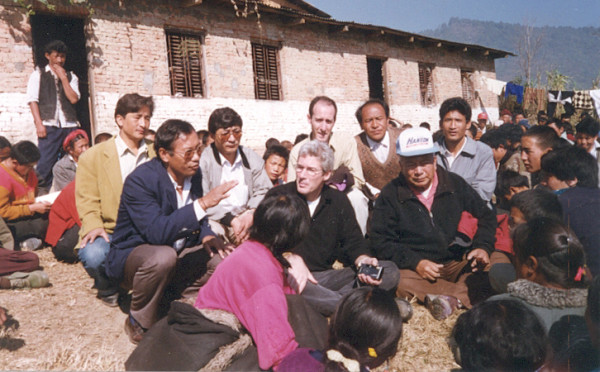
ICT Board Chair Richard Gere meets with Tibetan refugees in Nepal. (Photo: ICT)
I have always felt that the world should acknowledge the moral authority of His Holiness the Dalai Lama in representing the Tibetan people. Thus, I’ve encouraged my Tibetan colleagues to acknowledge all levels and means of international support for the Tibetan people, including financial assistance for programs inside Tibet. If a program benefits the Tibetan people, we should express gratitude for it, no matter the genesis of the support. It is important to remember that our struggle revolves around supporting the millions of Tibetans languishing under Chinese rule inside Tibet, and that to support them is to support the very core of our cause.
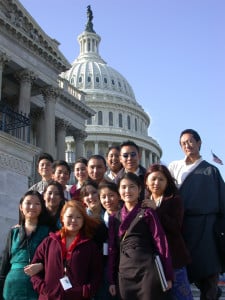
Participants in the Tibetan Youth Leadership program after their meetings on Capitol Hill. (Photo: ICT)
ICT has played a leading role in training young Tibetans as advocates, including the Tibetan Youth Leadership Program, in which we bring together Tibetan youth from the United States and Europe. We have also spearheaded the immensely successful Tibet Lobby Day that brings Tibetans and Tibet supporters to Washington to meet with their Members of Congress to advocate for specific legislation being considered at the time. The most recent Tibet Lobby Day was convened in the spring of 2014, where approximately 100 Tibetans and their supporters met with 150 congressional offices.
We also launched the Rowell Fund for Tibet to support Tibetans who are making a significant contribution in the fields of visual arts and media, and environmental and women’s rights. The Fund was initiated in 2003 in memory of late Galen and Barbara Rowell, longtime friends of Tibet.
![His Holiness the Dalai Lama presents ICT’s Light of Truth to Wang Lixiong [Washington, DC, October 7, 2009]](https://savetibet.org/wp-content/uploads/2013/03/25-Wang-Lixong-600-300x192.jpg)
Wang Lixiong receives ICT’s Light of Truth award from His Holiness the Dalai Lama in Washington, D.C. (Photo: ICT/Sonam Zoksang)
From the first Light of Truth Award in 1995 presented to New York Times editor and columnist A. M. Rosenthal, to mountaineer and author of Seven Years in Tibet Heinrich Harrer in 2002; from Vaclav Havel, former President of the Czech Republic in 2005, to Senator Claiborne Pell in 1997, from Archbishop Desmond Tutu to Elie Wiesel to Wang Lixiong in 2009, the Light of Truth Award celebrates significant contributions to the public understanding of Tibet and the fight for human rights and democratic freedoms for the Tibetan people. When the former Speaker of the Indian Parliament, the Honorable Rabi Ray, was presented the Light of Truth Award in Delhi, it was of special significance to me, not only because he was one of my mentors and a personal friend, but because he was accepting the award on behalf of the people of India, a small token of the Tibet movement’s gratitude to the unparalleled love and support that the Indians have bestowed on His Holiness the Dalai Lama and the Tibetan people.
Space does not permit me to list each recipient of the Light of Truth Award, but I would like to once again express my deep appreciation to each recipient for his/her outstanding contribution to the cause of Tibet.
ICT’s work in this area seeks to foster an understanding between the Chinese and Tibetan people, and to dissipate mistrust between the communities. In 1988, one of ICT’s first initiatives was to launch The Tibet Forum, the first Chinese language newspaper to be disseminated to thousands of Chinese in the West and in China. As a part of this initiative ICT has also developed ties with Chinese-language media, edited and translated books and materials, and conducted research on China’s rule of Tibet. The project also develops Chinese language material on Tibet and sends it to China. In 2002 ICT began publishing a quarterly Chinese language journal, Liaowang Xizang (Tibet Observer) to enhance and encourage the understanding of the issue of Tibet amongst the Chinese people.
This initiative has organized face-to-face meetings between Tibetans and Chinese, including numerous meetings between His Holiness the Dalai Lama and prominent leaders of the overseas Chinese community as well as a number of eminent scholars from mainland China. Most importantly, ICT played a critical role in assisting my team throughout the dialogue process in the 2000s. At times, the entire ICT staff was involved in one way or another, from conducting substantive research to arranging logistics for my delegation.
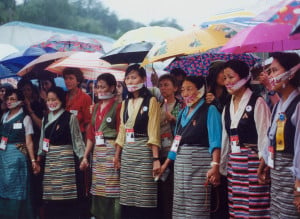
Tibetan women demonstrate at the 4th World Conference on Women in Beijing. (Photo: ICT)
ICT has been an integral part of the Tibet team working with the United Nations. I, and other ICT staff, have travelled many times to Geneva, Switzerland during the annual United Nations Human Rights Commission (UNHRC) to ensure that key human rights concerns are regularly raised in government and NGO statements at its annual sessions. In fact for several years I headed the Tibet UN initiative. Whether it has been through formal meetings with delegates to the UNHRC, networking with other non-governmental organizations, or hosting briefings on Tibet, ICT’s work has been critical to the Tibetan efforts at the UN. And ICT did not limit itself to the UN Human Rights Commission. We were deeply involved in such UN campaigns as the UN Earth Summit held in Rio de Janeiro in 1992, the Fourth World Conference on Women held in Beijing in 1995 and the 2001 UN Conference Against Racism.
In addition to our work at the United Nations, ICT has brought the Tibetan issue to the attention of governments around the world. In 1999 ICT opened its first overseas office in Amsterdam. Joined by offices in Berlin and Brussels, ICT has worked to effect change in Europe. In a very short period of time we have become the most effective Tibet support organization in Europe, creating political awareness about Tibet and lobbying for funding both inside and outside Tibet. ICT Europe also works closely with the Tibetan Parliament and has co-hosted several World Parliamentarian Conventions on Tibet. Our European offices have also taken on a leadership role in our work at the United Nations. The recent disappointing decision by the European Parliament to disband the Tibet Intergroup shows that our work there is not yet finished.
By coordinating His Holiness’s international outreach, we have sought to create strong, multilateral support for the Tibetan people. Our outreach has extended to every continent, creating an international coalition of world leaders eager to improve conditions in Tibet and to encourage a dialogue between China and Tibet. From Norway to South Africa, and Jordan to Israel, we have raised the profile of His Holiness the Dalai Lama and Tibet and brought pressure to bear on the Chinese government.
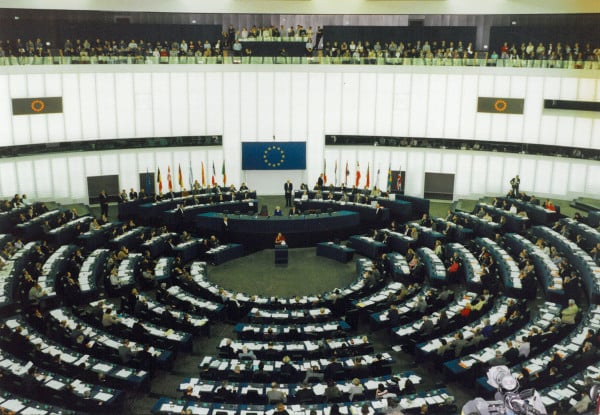
His Holiness the Dalai Lama addresses the European Parliament.
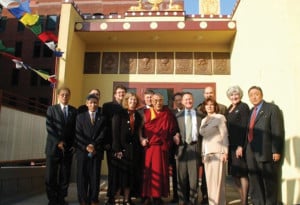
His Holiness the Dalai Lama with the ICT Board of Directors and senior staff in 2005 with Thupten Jimpa and Kasur Tashi Wangdi. (Photo: ICT)
Richard Gere has served on ICT’s Board of Directors for 24 years and has led us as the Chairman for more than fifteen years. He has never wavered in his determination to help His Holiness the Dalai Lama and the Tibetan people, and he has been instrumental in raising the profile of the organization and the cause. With his deep knowledge of the issue and profound appreciation for the Tibetan Buddhist cultural heritage, Richard is one of the most visible and effective spokespersons for the Tibet issue on the international arena. He has met with prominent political leaders, government officials in various parts of the world and has testified numerous times to the U.S. Congress, European Parliament and other legislative bodies on behalf of the Tibetan movement. He is one of the single largest donors to ICT, having given hundreds of thousands of dollars in personal contributions to the organization.
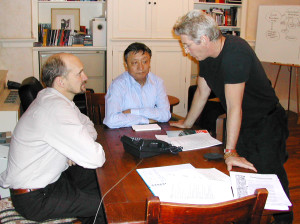
John Ackerly, Lodi Gyari and Richard Gere brief ICT members via conference call. (Photo: ICT)
I am excited that ICT’s new president, the Honorable Matteo Mecacci, brings new energy and youthfulness to the organization He comes to ICT as a former member of the Italian Parliament and Chairman of the OSCE Parliamentary Assembly Human Rights Committee. This background, coupled with his involvement in a number of global issues, make him the right leader to head ICT at a time when China’s global influence is on the rise and the attention of global leaders is being diverted to serious international crises, from financial concerns to global terrorism. And Matteo Mecacci is not new to the Tibet movement. He chaired the Italian Parliament Intergroup on Tibet and in 2009 he organized the Fifth World Parliamentary Conference on Tibet held at the Italian Parliament in Rome. As a member and Co-Chair of the International Network of Parliamentarians on Tibet, he has made important contributions to the Tibet cause, such as collaborating with ICT to organize the first international monitoring mission of Tibetan elections in exile. Because of his long standing involvement with the Tibetan issue he has a close relationship with His Holiness the Dalai Lama and the exile Tibetan leadership.
The path that ICT has established with the help of so many talented individuals remains solid, with many programs on “auto-pilot”. With a fabulous staff, devoted board and youthful president I am confident that ICT will continue to succeed in bringing attention to the plight of the Tibetan people, assistance to the Tibetan people all around the world, and support for His Holiness the Dalai Lama and his Middle Way approach. I urge ICT’s board, staff, membership and supporters to rededicate yourselves to helping the Tibetan people by leading and being part of the International Campaign for Tibet.
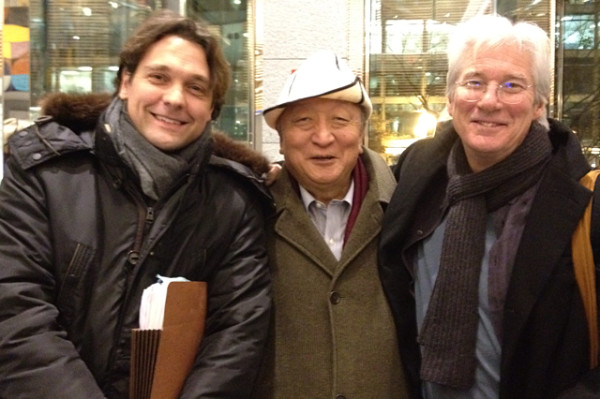
Matteo Mecacci, Lodi Gyari and Richard Gere in Washington, D.C. December 2014. (Photo: ICT)
I am grateful for the complete confidence and trust that the office of His Holiness the Dalai Lama and the Kashag have extended to me and to ICT. Our accomplishments speak volumes, whether it is in advancing U.S. and international policy on Tibet, providing concrete assistance to the Tibetan people, or developing the extensive network of Tibet supporters both inside and outside of government. For over twenty-five years we have called the world’s attention to the injustices and brutality being suffered by the people of Tibet.
When institutions and individuals are involved in critically important work there will always be obstacles and roadblocks. In fact, we Tibetans believe that the more noble and righteous the cause, the more hindrances will occur. Both ICT and I have had our share of such experiences, which in some circumstances caused disappointment and even sorrow, but we have never allowed this to distract us from our mission. As a matter of fact, I consider myself fortunate that I have been able to devote nearly five decades of my life to serving His Holiness and the Tibetan people uninterrupted, both here in the United States and India. The benefit of my contribution will be judged by others and by history, but I have conducted myself with honesty, integrity and fairness. Most important of all, I have taken the Buddhist principle of ‘non-harming’ very seriously and made this precept central to my conduct.
Tibet’s Buddhist-inspired worldview is at the heart of our struggle and it has been my privilege to create more awareness of our rich cultural heritage by being part of such organizations as the Conservancy for Tibetan Art and Culture. I have been able to play a crucial role in a number of international Buddhist conferences and in the establishment of the International Buddhist Confederation, an umbrella organization headquartered in India. I firmly believe that the core of the Tibetan people’s struggle is to preserve its distinctive identity: the Tibetan Buddhist cultural heritage. Similarly I believe Buddhism is the most important vehicle for the future in developing a better understanding between the Tibetan and Chinese people.
At ICT we have always recognized that the organization is a vehicle for taking the Tibet issue forward in every way possible. I am grateful that I was able to devote an important part of my time in heading the negotiations with the Chinese leadership as His Holiness’s Special Envoy—as our entire mission has been to support His Holiness’s Middle Way approach. I am also grateful that I could spend time encouraging and advising individuals and NGOs working inside Tibet since it must be our priority to empower the people inside Tibet.
I have also been fortunate to work with a team of deeply dedicated, professional and skillful Tibetan colleagues like Bhuchung Tsering and Tsering Jampa. I have relied heavily on Bhuchung, whether in my work at ICT or as a part of my negotiating team with the Chinese government. Bhuchung has always been reluctant to be in the limelight, but his role has been critical. Tsering Jampa is a great campaigner as well as a capable administrator. ICT’s successful entry into Europe was largely a result of her hard work and leadership. Tibetans like Bhuchung Tsering and Tsering Jampa have much to offer the Tibetan movement and I hope that they will continue to have that opportunity.
We Tibetans must be mindful that it is our job to remain at the forefront of our struggle and to inspire those who support us. After all, the cause we are fighting for is the cause of our homeland, Tibet. I have never felt that the Tibetan people, or myself for that matter, were entitled to any political, economic, or humanitarian support. No government, institution or individual owes us anything; we are no more special than any other people in similar circumstances. Thus, I strongly believe that we Tibetans must remain ever grateful for every bit of help and support that we have received.
There are others who have played a crucial role in the success of all the efforts mentioned above, but they need to remain anonymous at this time. My gratitude for their support, guidance and friendship can never be repaid. Furthermore, if I acknowledged all of my talented and effective colleagues by name this would become an unending memo. However, I must be allowed to make special mention of Lesley Friedell Rich, who has been my assistant for twenty years. Her help and support has been of immense value; she has even made herself unpopular at times on my behalf!
On a personal note, I would like to acknowledge the tremendous support I have received from my family, particularly my loving and strong wife, Dawa Chokyi. Dawa opened our home countless times to our friends and supporters, especially in our early years in the U.S. She also felt deeply touched by the genuine love and affection that was shown to us by our friends. She almost singlehandedly raised our six children as good human beings, deeply rooted in the rich Tibetan Buddhist heritage while I spent half of my life traveling for work. I am blessed to have a life partner who is compassionate, wise, caring and decisive.
The support and guidance I have received from my parents has given me tremendous personal strength and inspiration. During my early years of service to His Holiness and the Tibetan people, my Ama las gave me financial support by running a small restaurant in Darjeeling and later running a small canteen in the outskirts of Delhi. But what makes me most nostalgic and proud is that when my father was terminally ill with cancer, he refused to allow me to prolong my stay with him in Delhi but asked me to return to serve His Holiness the Dalai Lama and the Tibetan cause. That is precisely what I did and I was not able to be by his side when he passed away. Despite my grief at his passing, I felt then, and still feel, a sense of pride and gratitude because I carried out his wishes, and have had the honor of continuing this service to His Holiness for so many decades.
I am very fortunate to have been born to an ancient Tibetan family from Kham in Eastern Tibet. My parents taught me the importance of loyalty and honor and my upbringing as a young novice monk in the monastery ensured a deep-rooted sense of respect and appreciation for our Buddhist heritage.
I spent my formative years in India. Growing up in that great country and being mentored by some of the extraordinary leaders of India has given me the opportunity to broaden my understanding of global issues, while also sharpening my own sense of dedication to the Tibetan cause. My gratitude and love for the people of India is profound.
Almost three decades ago I came to the United States. When I decided to become a citizen of this country I did not do it casually because the oath that one takes is solemn. But after much reflection I came to the full realization that instead of detracting from my work for the Tibetan cause, I could perhaps be more effective in helping my people by becoming a U.S. citizen rather than remaining stateless. Today I am a proud Tibetan-American with deep appreciation for the principles and values that this nation stands for. Nevertheless it is a sad thing even at this stage of my life that I do not have a place to call ‘home’. I can never retire from being a Tibetan for as long as I live.
I feel a deep satisfaction that I have remained faithful to the wishes of my lineage head, His Holiness the late Dudjom Rinpoche and my late father, Gyari Nima, by serving His Holiness the Dalai Lama with full devotion and loyalty. I remember as if it was just yesterday, the day I had my last audience with His Holiness Dudjom Rinpoche in New Delhi in the late 1960s. He held both my hands and touching our foreheads together, he said with deep affection, “In this life your zepa (action or activity) is to serve Gyalwa Yeshe Norbu (His Holiness the Dalai Lama).”
In conclusion, I once again express my deep felt gratitude to my mentors, my friends, my colleagues, and supporters like you for making my work more meaningful in serving His Holiness the Dalai Lama and the great people of Tibet.

